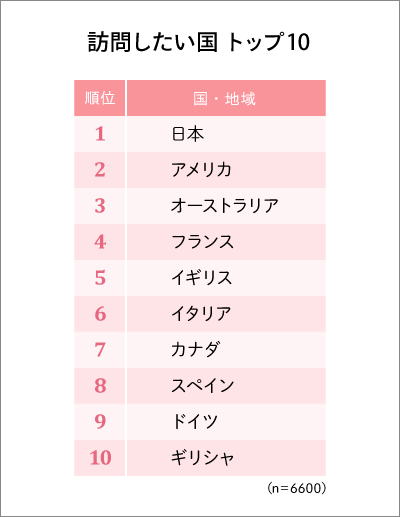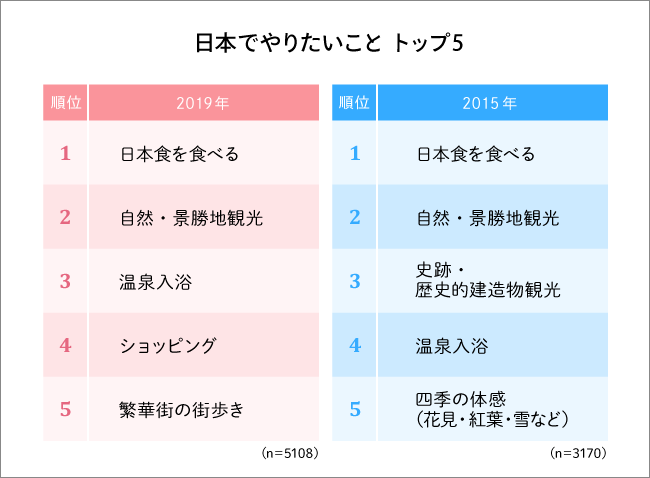This series explores insights for future inbound business from the "Japan Brand Survey 2019," conducted in 20 countries and regions in December 2018. Starting now, we will consider the future of inbound tourists by comparing past and current data.
According to the Japan National Tourism Organization (JNTO), the annual number of foreign visitors to Japan (estimated) in 2018 reached approximately 31,191,900, an 8.7% increase from the previous year, finally surpassing the 30 million mark.
While numbers are expected to grow even more after 2020, where do these visitors come from, and what draws them to Japan?
Nearly 80% want to visit Japan! Will European visitors increase in the future?
First, let's look at the 2019 intention to visit Japan (the combined total of those who "plan to travel to Japan within the next year" and those who "have not set a date but want to go someday"). Across all 20 countries and regions, the result was very high at 77.4%.

Compared to fiscal year 2018, this is +1.4 points, essentially flat, but still maintaining a high score. By country/region, Hong Kong was highest at 98.3%. This means nearly everyone wants to visit Japan. While Asian countries and regions generally show high scores, other areas also exhibit strong visit intentions from countries where many respondents expressed liking Japan ( see Part 1 of this series ), such as Italy (81.7%), Russia (73.3%), and Turkey (71.7%).
Compared to 2018, scores have increased in France (+5.4pt), Germany (+7.7pt), Italy (+10pt), and Russia (+5.3pt), suggesting an expected rise in tourists from Europe.
When we began surveying in 2012, the overall intention to visit Japan was 67.7%. While an exact comparison is difficult due to changes in the surveyed regions, it is striking that the score has increased by about 10 points over seven years.
Comparing by country/region, those showing a score increase of 10 points or more are Hong Kong (+20.5pt), Thailand (+20pt), the United States (+17.7pt), the United Kingdom (+11.5pt), and Australia (+18.5pt). This indicates a significant rise in visit intentions not only from Asia but also from countries in Europe, America, and Australia.
Japan is the most popular destination in Asia. Its competitors are the USA, Italy, and Australia?
So, how popular is Japan as a travel destination compared to other countries worldwide? When asked "Which country would you like to visit in the future?" from a list of popular tourist destinations (including Japan), Japan ranked first overall across 20 countries/regions with 48.6%. The United States came in second (38.9%), followed by Australia in third (37.9%).

However, there are differences by region, and Japan is not ranked first in every country or region.
While Japan ranked first in most Asian countries and regions, in North America, European countries like Italy and Australia were more popular, with Japan placing eighth. In Europe, the United States ranked first and Japan second. In Australia, Canada ranked first, with Japan tied for second place with the United States.
Even within North America, Europe, and Australia, Japan ranked first among Asian destinations as a "country they would like to visit in the future." However, the number of visitors to Japan from these regions remains low, and compared to competing countries in Europe, America, and Australia, Japan's presence cannot be said to be significant.
When asked about barriers to visiting Japan, the top overall reason was "high travel costs."
Furthermore, in the UK, France, and Germany—where interest in visiting Japan is growing—the top reason cited was not high travel costs, but rather "it's far away/takes too long to get there." This suggests potential visitors who would come to Japan during periods when they can take extended vacations, given the right incentive.
Presenting experiences unique to Japan and "how to enhance its presence as a travel destination" appears to be the key to increasing the number of visitors to Japan going forward.
Many visitors come seeking authentic Japanese cuisine. Is travel shifting toward "things + experiences"?
Finally, let's examine what visitors seek when coming to Japan. When asking those intending to visit Japan about their "desired activities," "eating Japanese food" ranked overwhelmingly first. It led the second-place choice, "nature/scenic spot sightseeing," by over 20 percentage points.
Results vary slightly by country/region, but "Japanese cuisine" is popular enough to rank first in every single one. A global Japanese food boom is underway, suggesting that people who have experienced Japanese food in their home countries are coming to Japan seeking the authentic taste.
Furthermore, in the survey four years prior (2015), the top five things to do in Japan were "Eat Japanese food," "Visit natural and scenic spots," "Visit historical sites and buildings," "Bathe in hot springs," and "Experience the four seasons." By 2019, the results were "Eat Japanese food," "Visit natural and scenic spots," "Bathe in hot springs," "Go shopping," and "Stroll through downtown areas."

Since it's often said that the travel style of visitors to Japan has shifted from "things" to "experiences," "shopping" might seem surprising. However, especially among tourists from Europe and America, many tend to buy souvenirs like kimonos or knives that embody Japanese tradition and craftsmanship. "Shopping" here isn't just about the items; it also encompasses cultural experiences.
Going forward, rather than choosing between goods or experiences, a travel style combining both goods and experiences is likely to become mainstream.
Furthermore, based on this survey's findings, we can anticipate an influx of tourists from countries farther away, such as Europe, America, and Australia.
As more people visit from countries with historically lower numbers of visitors to Japan, and as travel styles evolve, increasingly diverse needs may emerge, potentially creating new business opportunities.
Next time, we'll delve deeper into the travel destinations of international visitors in Japan.
Overview of the Japan Brand Survey 2019
・Purpose: To understand overseas consumers' perceptions and actual behaviors regarding the "Japan Brand" in general, including food, tourism, and Japanese products
・Target Areas: 20 countries and regions
China (Group A = Beijing, Shanghai, Guangzhou; Group B = Shenzhen, Tianjin, Chongqing, Suzhou, Wuhan, Chengdu, Hangzhou, Dalian, Xi'an, Qingdao), Hong Kong, Taiwan, South Korea, India, Singapore, Thailand, Indonesia, Malaysia, Vietnam, Philippines, Australia, United States (Northeast, Midwest, South, West), Canada, United Kingdom, France, Germany, Italy, Russia, Turkey
*This time, Brazil—which showed little change in past survey trends—was excluded, while Turkey, gaining attention for inbound tourism, was added.
・Survey Method: Online survey
・Respondent criteria: Men and women aged 20–59 *Middle-income level and above
*Definition of "middle-income class" (income criteria): Criteria set for each country based on national average income (OECD statistics, etc.) and social class classification (SEC)
・Sample size: China: 300 each for A and B groups, total 600; USA: 600; Other regions: 300 each, total 6,600
・Survey Period: December 2018
・Research organization: Video Research Ltd.







